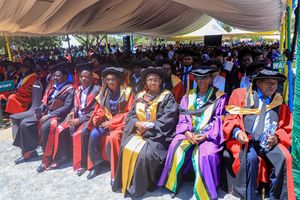
Reports indicate that Tanzania’s higher education enrolment rate stands at just 6.1 percent, far behind Kenya’s 11 percent and the sub-Saharan African average of 9.4 percent. PHOTO | COURTESY
Dar es Salaam. Tanzania is in a race against time to expand its higher education enrolment capacity and bridge the gap with other African countries, The Citizen has learnt.
Despite efforts to boost access to university education, the country’s Gross Enrolment Ratio (GER) remains significantly low.
Reports indicate that Tanzania’s higher education enrolment rate stands at just 6.1 percent, far behind Kenya’s 11 percent and the sub-Saharan African average of 9.4 percent.
According to GlobalEconomy.com, Tanzania recorded a tertiary school enrolment rate of 5.43 percent in 2022, ranking last among 18 African countries surveyed. Algeria led with a 53.4 percent enrolment rate, followed by Morocco at 46.18 percent.
This disparity highlights the urgent need for strategic interventions to improve access to university education in Tanzania.
For years, Tanzanian universities have struggled with overcrowded lecture halls, inadequate laboratories, and limited student accommodation.
The shortage of classrooms and learning infrastructure has significantly constrained student admissions and affected the quality of education.
However, the government’s commitment to reversing this trend is taking shape through the Higher Education for Economic Transformation (HEET) project, a $425 million initiative funded in collaboration with the World Bank.
The project aims to expand higher education capacity by constructing modern classrooms, improving research facilities, equipping laboratories, and increasing student housing across various universities.
Among the beneficiaries of the HEET project is Ardhi University, a specialised institution focusing on land, urban planning, and architecture.
Historically, the university has struggled with inadequate training spaces, forcing it to rent facilities from other institutions.
“We have had to lease studio spaces and laboratories from other universities, which increases operational costs,” said Ardhi University Vice Chancellor Evaristo Liwa.
“The new infrastructure will allow us to enrol nearly 7,000 more students, bringing our total enrolment to 14,000.”
Under the HEET project, Ardhi University has been allocated $29 million, with $14.5 million dedicated to constructing four modern learning buildings, complete with classrooms and training areas. Additionally, $8 million is being used to establish a new campus in Sengerema, Mwanza Region.
“This expansion will completely change our capacity. We will not only increase admissions but also improve our research and innovation environment,” Prof Liwa added, during an interview.
The transformation is not limited to Ardhi University. Other institutions, including the University of Dar es Salaam (UDSM), the Nelson Mandela African Institution of Science and Technology (NM-AIST), and the University of Dodoma (UDOM), are also undergoing significant expansions under the HEET project.
The chairperson of Parliament’s Education, Culture and Sports Committee, Ms Husna Sekiboko, emphasised the importance of government funding in higher education, when the committee visited Ardhi University’s ongoing projects over the weekend.
“If the government had not invested in these universities, the lack of classrooms and training facilities would have continued to affect education quality. This project is a game changer,” she said.
Education, Science and Technology deputy minister Omary Kipanga revealed that Ardhi University received over Sh50 billion ($29 million) from the project to improve both its main campus in Dar es Salaam and the new Sengerema campus.
“The government is committed to improving learning environments in universities to meet global standards. We are constructing facilities with modern infrastructure, including classrooms and laboratories, to accommodate more students,” Mr Kipanga stated.
Higher education analysts believe the HEET project is crucial in positioning Tanzanian universities on the international stage.
Higher education researcher Emmanuel Mahiga asserted that increasing enrolment while improving quality is key to enhancing Tanzania’s global competitiveness.
“For years, our universities have struggled to attract international students and faculty due to infrastructural challenges. With this investment, institutions like Ardhi University can now improve their global ranking and attract talent from across Africa,” he said.
He added that increasing university capacity will also drive economic growth by producing a skilled workforce for various sectors.


